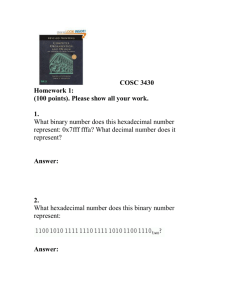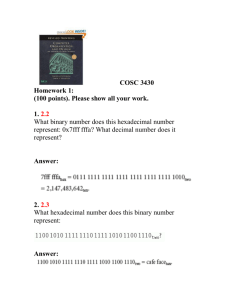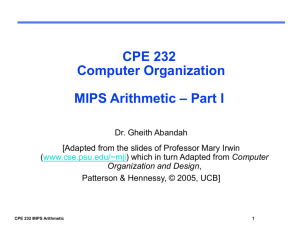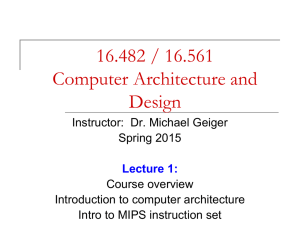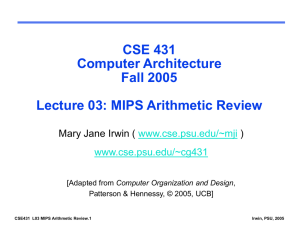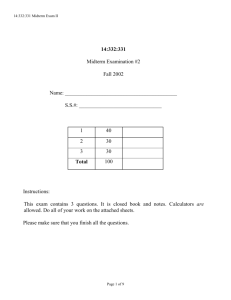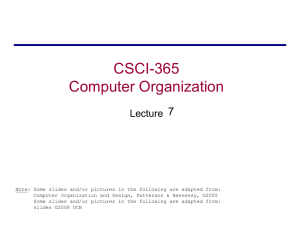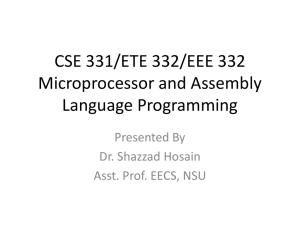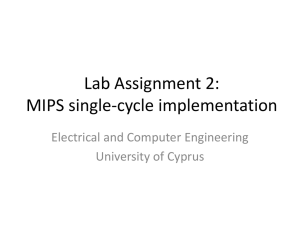ppt
advertisement
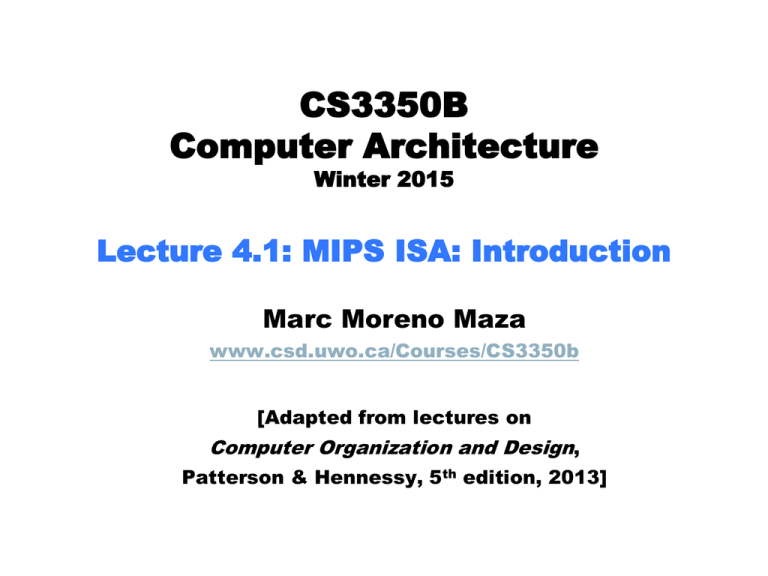
CS3350B Computer Architecture Winter 2015 Lecture 4.1: MIPS ISA: Introduction Marc Moreno Maza www.csd.uwo.ca/Courses/CS3350b [Adapted from lectures on Computer Organization and Design, Patterson & Hennessy, 5th edition, 2013] Abstraction of Machine Structures Levels of representation Application (ex: browser) Compiler Software Hardware Assembler Operating System (Mac OSX) Processor Memory I/O system Instruction Set Architecture Datapath & Control Digital Design Circuit Design Transistors 2 Instructions: Language of the Computer Instruction Set The repertoire of instructions of a computer Different computers have different instruction sets Early computers had very simple instruction sets But with many aspects in common Simplified implementation Many modern computers also have simple instruction sets 4 The MIPS Instruction Set Used as the example throughout the book Stanford MIPS commercialized by MIPS Technologies (www.mips.com) Large share of embedded core market Applications in consumer electronics, network/storage equipment, cameras, printers, … Typical of many modern ISAs See MIPS Reference Data tear-out card, and Appendixes B and E 5 spim Assembler and Simulator spim is a simulator that runs MIPS32 assembly language programs It provides a simple assembler, debugger and a simple set of operating system services Interfaces: Spim, XSpim, PCSpim, QtSpim (new UI, cross-platform) See installation and user guide at http://pages.cs.wisc.edu/~larus/spim.html Arithmetic Operations Add and subtract, three operands Two sources and one destination add a, b, c # a gets b + c All arithmetic operations have this form Design Principle 1: Simplicity favors regularity Regularity makes implementation simpler Simplicity enables higher performance at lower cost 7 Arithmetic Example C code: f = (g + h) - (i + j); Compiled MIPS code: add t0, g, h add t1, i, j sub f, t0, t1 # temp t0 = g + h # temp t1 = i + j # f = t0 - t1 8 Register Operands Arithmetic instructions use register operands MIPS has a 32 × 32-bit register file Assembler names Use for frequently accessed data Numbered 0 to 31 32-bit data called a “word” $t0, $t1, …, $t9 for temporary values $s0, $s1, …, $s7 for saved variables Design Principle 2: Smaller is faster c.f. main memory: millions of locations 9 Register Operand Example C code: f = (g + h) - (i + j); f, …, j in $s0, …, $s4 Compiled MIPS code: add $t0, $s1, $s2 add $t1, $s3, $s4 sub $s0, $t0, $t1 10 Memory Operands Main memory used for composite data To apply arithmetic operations Each address identifies an 8-bit byte Words are aligned in memory Load values from memory into registers Store result from register to memory Memory is byte addressed Arrays, structures, dynamic data Address must be a multiple of 4 MIPS is Big Endian Most-significant byte at least address of a word c.f. Little Endian: least-significant byte at least address 11 Memory Operand Example 1 C code: g = h + A[8]; g in $s1, h in $s2, base address of A in $s3 Compiled MIPS code: Index 8 requires offset of 32 4 bytes per word lw $t0, 32($s3) add $s1, $s2, $t0 offset # load word base register 12 Memory Operand Example 2 C code: A[12] = h + A[8]; h in $s2, base address of A in $s3 Compiled MIPS code: Index 8 requires offset of 32 lw $t0, 32($s3) # load word add $t0, $s2, $t0 sw $t0, 48($s3) # store word 13 Registers vs. Memory Registers are faster to access than memory Operating on memory data requires loads and stores More instructions to be executed Compiler must use registers for variables as much as possible Only spill to memory for less frequently used variables Register optimization is important! 14 Immediate Operands Constant data specified in an instruction addi $s3, $s3, 4 No subtract immediate instruction Just use a negative constant addi $s2, $s1, -1 Design Principle 3: Make the common case fast Small constants are common Immediate operand avoids a load instruction 15 The Constant Zero MIPS register 0 ($zero) is the constant 0 Cannot be overwritten Useful for common operations E.g., move between registers add $t2, $s1, $zero 16 Overview: MIPS R3000 ISA Instruction Categories Registers Computational Load/Store Jump and Branch Floating Point coprocessor Memory Management Special R0 - R31 PC HI LO 3 Basic Instruction Formats: all 32 bits wide OP rs rt OP rs rt OP rd sha immediate jump target funct R-format I-format J-format 17 MIPS Register Convention Name $zero $at $v0 - $v1 $a0 - $a3 $t0 - $t7 $s0 - $s7 $t8 - $t9 $k $gp $sp $fp $ra Register Usage Number 0 constant 0 (hardware) 1 2-3 4-7 8-15 16-23 24-25 26-27 28 29 30 31 reserved for assembler returned values arguments temporaries saved values temporaries Interrupt/trap handler global pointer stack pointer frame pointer return addr (hardware) Preserve on call? n.a. n.a. no yes no yes no yes yes yes yes yes 18 MIPS ISA Selected Instruction Set Category Arithmetic Data Transfer Cond. Branch Uncond. Jump Instr OP/funct Example Meaning add R 0/32 add $s1, $s2, $s3 $s1 = $s2 + $s3 subtract R 0/34 sub $s1, $s2, $s3 $s1 = $s2 - $s3 add immediate I 8 addi $s1, $s2, 6 $s1 = $s2 + 6 or immediate I 13 ori $s1, $s2, 6 $s1 = $s2 v 6 load word I 35 lw $s1, 24($s2) $s1 = Memory($s2+24) store word I 43 sw $s1, 24($s2) Memory($s2+24) = $s1 load byte I 32 lb $s1, 25($s2) $s1 = Memory($s2+25) store byte I 40 sb $s1, 25($s2) Memory($s2+25) = $s1 load upper imm I 15 lui $s1, 6 $s1 = 6 * 216 br on equal I 4 beq $s1, $s2, L if ($s1==$s2) go to L br on not equal I 5 bne $s1, $s2, L if ($s1 != $s2) go to L set on less than R 0/42 slt set on less than immediate I 10 slti $s1, $s2, 6 if ($s2<$s3) $s1=1 else $s1=0 if ($s2<6) $s1=1 else $s1=0 jump J 2 j 250 go to 1000 jump register R 0/8 jr $t1 go to $t1 jump and link J 3 jal 250 go to 1000; $ra=PC+4 $s1, $s2, $s3 19 Unsigned Binary Integers Given an n-bit number n1 x xn12 xn2 2 x12 x0 2 1 0 Range: 0 to +2n – 1 Example n2 0000 0000 0000 0000 0000 0000 0000 10112 = 0 + … + 1×23 + 0×22 +1×21 +1×20 = 0 + … + 8 + 0 + 2 + 1 = 1110 Using 32 bits 0 to +4,294,967,295 20 2s-Complement Signed Integers Given an n-bit number n1 x xn12 xn2 2 x12 x0 2 1 0 Range: –2n – 1 to +2n – 1 – 1 Example n2 1111 1111 1111 1111 1111 1111 1111 11002 = –1×231 + 1×230 + … + 1×22 +0×21 +0×20 = –2,147,483,648 + 2,147,483,644 = –410 Using 32 bits –2,147,483,648 to +2,147,483,647 21 2s-Complement Signed Integers Bit 31 is sign bit 1 for negative numbers 0 for non-negative numbers –(–2n – 1) can’t be represented Non-negative numbers have the same unsigned and 2s-complement representation Some specific numbers 0: 0000 0000 … 0000 –1: 1111 1111 … 1111 Most-negative: 1000 0000 … 0000 Most-positive: 0111 1111 … 1111 22 Signed Negation Complement and add 1 Complement means 1 → 0, 0 → 1 x x 1111...1112 1 x 1 x Example: negate +2 +2 = 0000 0000 … 00102 –2 = 1111 1111 … 11012 + 1 = 1111 1111 … 11102 23 Sign Extension Representing a number using more bits In MIPS instruction set addi: extend immediate value lb, lh: extend loaded byte/halfword beq, bne: extend the displacement Replicate the sign bit to the left Preserve the numeric value c.f. unsigned values: extend with 0s Examples: 8-bit to 16-bit +2: 0000 0010 => 0000 0000 0000 0010 –2: 1111 1110 => 1111 1111 1111 1110 24 Next Lecture: MIPS Instruction Representation 25
